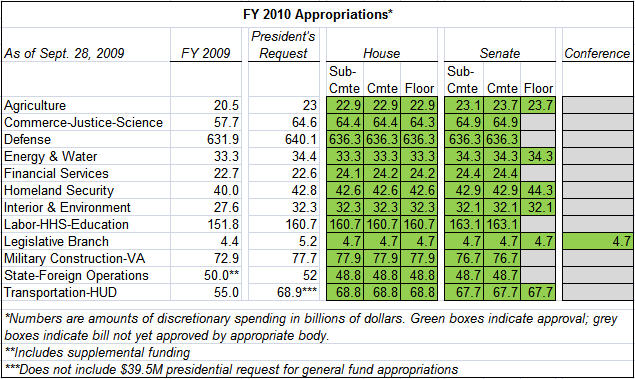
Congress Attempts to Wrap up Appropriations
9/29/2009
With the end of the fiscal year quickly approaching on Sept. 30, congressional leaders plan to pass a continuing resolution (CR) to keep government agencies funded through the end of October and allow additional time for appropriations work to continue. Although not a guarantee, the additional time should allow Congress to finish its appropriations work, preventing the need for an omnibus spending bill before the end of the year.
The FY 2010 appropriations process will consume Congress over the coming weeks, as both chambers work to complete the government's twelve annual spending bills and pass them on to the president for his signature. The House moved quickly in 2009 and passed all of its appropriations measures before the August recess. Alternatively, the Senate passed only four spending bills before leaving Washington for the summer. Having completed two more appropriations bills since the break, the upper chamber still has six spending bills to pass and then must reach agreement with the House on a compromise version for each of those bills.
The only appropriations legislation that has successfully passed both chambers and been reconciled is the bill funding the legislative branch. The House agreed to the conference report, which includes the text of the (CR), on Sept. 25, and the Senate is likely to pass the conference report the week of Sept. 28, before the end of the fiscal year.
Two of the six bills remaining for the Senate include what are possibly the most contentious spending measures – the Defense Department and Labor-HHS-Education spending bills. With rancorous debate and an abundance of amendments typifying Senate appropriations proceedings, such as debate on the recently completed Interior-Environment funding bill, legislative wrangling over Defense and Labor-HHS-Education appropriations bills could push lawmakers to the end of their one-month extension under the CR.
Exacerbating defense-spending matters are current foreign policy debates over troop levels in Afghanistan and missile defense in Eastern Europe. The Obama administration also has several demands for the Senate's defense bill, including increased funding for Afghan security forces and the removal of funding for the C-17 transport plane. To date, Congress has largely acquiesced to the administration's defense-spending demands, including cancellation of the F-22 fighter jet, the VH-71 presidential helicopter, and the F-35 alternate engine; the matters over funding for security forces and the C-17 represent some of the remaining defense-spending battles the administration has left to fight. On the other hand, Obama's record on gaining congressional approval for domestic spending demands is less impressive.
Of the five appropriations measures passed by both houses, but that have yet to be reconciled, sizeable differences exist between House and Senate versions of the Agriculture, Energy & Water, Homeland Security, and Transportation-HUD bills. This includes an $800 billion difference between Agriculture bills, a $1 billion difference between Energy & Water bills, a $1.7 billion difference between Homeland Security bills, and a $1.1 billion difference between Transportation-HUD bills.
Despite these sizable obstacles, congressional leaders believe that one month is enough time to sort through all the differences over spending measures. If they are not able to finish before the CR runs out, Congress could either pass another CR or lump all the remaining bills together and pass them at once – what's known as an omnibus appropriations bill. Omnibus spending bills are less transparent and deny the media and watchdogs groups the proper scrutiny of specific spending measures. It is also more likely that legislators can insert controversial provisions at the last second because of the expedited timeframe these bills are usually considered under.



